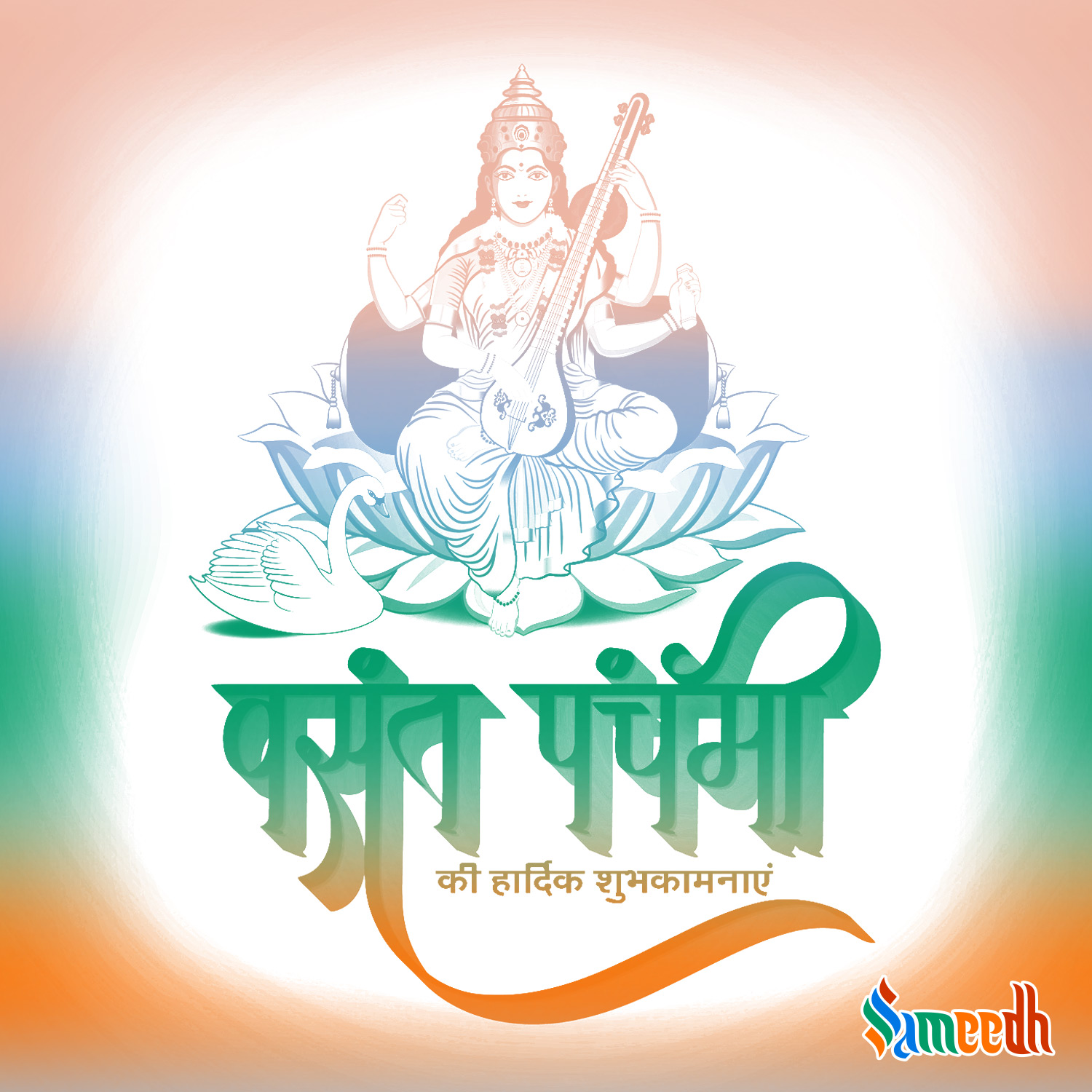Vasant Panchami is celebrated on the fifth day of the Hindu month Magha, which signals the end of winter and the arrival of spring. This day is also celebrated as ‘Saraswati Puja’ in many parts of India in devotion to Maa Saraswati.

Vasant Panchami is a Hindu festival celebrated on the fifth day of the Hindu lunar month Magha (January-February in the English calendar), signalling the end of winter and the arrival of spring.
After Makar Sankranti, the sun begins its northward journey from the tropic of Capricorn, ushering in pleasant days as winter passes away. A lovely shift in season heralds the arrival of spring as the subcontinent finds relief from the severe winter. Spring blooms fully around the time of the Holi, after a month of transformation beginning with Vasant Panchami.
Saraswati puja, a day dedicated to Goddess Saraswati, is celebrated in many parts of India on this day. Saraswati pujas are held in homes, and worshippers flock to Saraswati temples. Sri Panchami, one of Goddess Lakshmi’s names, is celebrated in south India. This is also a day when Goddess Parvati sent Kaam Dev to disrupt Lord Shiv’s penance on Vasant Panchami. Vasant Panchami is thus attributed to the Hindu trinity’s three goddesses. To put it another way, it’s a day dedicated to the celebration of wisdom, abundance, energy and creativity.
Association of Vasant Panchami with river Saraswati and Goddess Saraswati
The Saraswati River was a once-thriving river in northwest India, which eventually dried up. The Himalayan glaciers would melt with the arrival of spring thus, increasing the flow of the Saraswati River. The mustard plants that grew along the river’s banks used to bloom abundantly, creating a beautiful view. The ancient Indian rishis often had their ashrams on the shores of the Saraswati River. It is believed that Rishi Veda Vyas resided on the bank of river Saraswati. The Vedas, Upanishads, and other scriptures were written and compiled here on the banks of the Saraswati River. As a result, Goddess Saraswati, the deity of knowledge and wisdom, became associated with the river.
It is also known as a season of eternal love
Lord Shiv was once said to be in a deep state of penitence, according to legend. During that time, a Rakshas named Tarakasur began wreaking havoc all over the world, emboldened by the fact that Bhagwan Shiv had become an ascetic and had been immersed in meditation for a long time and it was unlikely that he would ever marry again after the self-immolation of Sati (Shiv’s first wife). Tarakasur had attained a boon that only Shiv’s son would be able to kill him. Meanwhile, Sati was reborn as Parvati. To obtain Bhagwan Shiv’s love, Parvati had performed rigorous penance. Shiv, on the other hand, remained firm in his decision.
Parvati then sent Kaam Dev (the god of love) to awaken Shiv from his meditation. On the day of Vasant Panchami, Kaam Dev approached Shiv and created an artificial spring in Kailash in order to entice Bhagwan Shiv out of his penance. Shiv eventually awakens, but Kaam Dev was burned to ashes. After that, he embraced Parvati as his wife. Bhagwan Kartikey, the son of Shiv and Parvati, went on to defeat Tarakasur.
Basant Panchami in other parts of India
In Punjab, Vasant Ritu is known as the Kite Festival. People wear yellow clothing and eat yellow rice. Yellow turbans are worn by the Sikhs. On the first Vasant Panchami following their wedding, married couples in Maharashtra visit temples dressed in yellow. On this day, people in Rajasthan wear jasmine garlands. Farmers across India, celebrate on this day because the mustard crop’s yellow flowers adorn the fields making it a pleasant sight. It is also regarded as auspicious to start anything new, get married, or do Gruha pravesh on this day.
Attire
On Vasant Panchami, people typically dress in yellow or saffron-colored clothes as a way to honor the goddess Saraswati, who is the central focus of the festival. Yellow and saffron are considered auspicious and festive colors in Hinduism, and they are associated with the goddess of knowledge, wisdom, and the arts.
For men, traditional attire on Vasant Panchami includes kurtas (long tunic-like shirts) and pyjamas (loose-fitting pants) in shades of yellow or saffron. These garments are typically made of comfortable and lightweight fabrics such as cotton, and they are often adorned with intricate embroidery and embellishments. Turbans are also commonly worn by men on Vasant Panchami, and they are often adorned with bright and colorful patterns.
For women, traditional attire on Vasant Panchami includes sarees (a garment consisting of a long piece of cloth draped over the body) and salwar kameez (a garment consisting of a long tunic worn over loose pants) in shades of yellow or saffron. These garments are typically made of rich fabrics such as silk, and they are often adorned with intricate embroidery and embellishments. Dupattas (long scarves) are also commonly worn with salwar
Food
On Vasant Panchami, people typically offer yellow-colored sweets and rice to the goddess Saraswati as a way to honor and seek her blessings. Some popular foods that are often served on this occasion include:
Kesar peda: A sweet made from condensed milk and saffron.
Kesar laddoo: A round, sweet dessert made from flour, sugar, and saffron.
Kesar halwa: A sweet made from semolina, sugar, and saffron.
Kesar kulfi: A type of ice cream made with saffron and other flavors.
Yellow rice: Rice cooked with yellow food coloring and spices.
In addition to these dishes, Vasant Panchami is also traditionally marked by the exchange of sweets and snacks such as ladoos, barfi, and chikki. These sweets are often given as gifts and shared with friends and family as a way to celebrate the occasion.
Overall, the food served on Vasant Panchami is an important part of the celebration and is chosen to be both delicious and nourishing. The sharing of food is an integral part of the festival and is seen as a way to bring people together and celebrate the abundance of the season.
Rituals
Vasant Panchami is a Hindu festival that is celebrated in honor of the goddess Saraswati, the goddess of knowledge, wisdom, and the arts. On this day, people typically offer prayers and perform puja (worship) ceremonies to seek the blessings of the goddess and to invoke her guidance in their studies and intellectual pursuits.
The puja ceremony on Vasant Panchami typically involves the offering of flowers, incense, and other ritual items to the goddess. A puja plate or tray is set up with these offerings, and it is placed in front of an idol or picture of the goddess. The puja plate may also include a small pot of water, which is placed in front of the idol as a symbol of the goddess’ purity and wisdom.
During the puja ceremony, people recite prayers and mantras to the goddess and make offerings of food, such as sweets and rice. They may also perform aarti (a ritual in which a lighted lamp is waved in front of the idol) as a way to show their devotion and respect for the goddess.
After the puja ceremony, people may also participate in other activities such as singing devotional songs, reading religious texts, and visiting temples and educational institutions to seek the blessings of the goddess.
Most popular Prayer is Saraswati Stotra .
